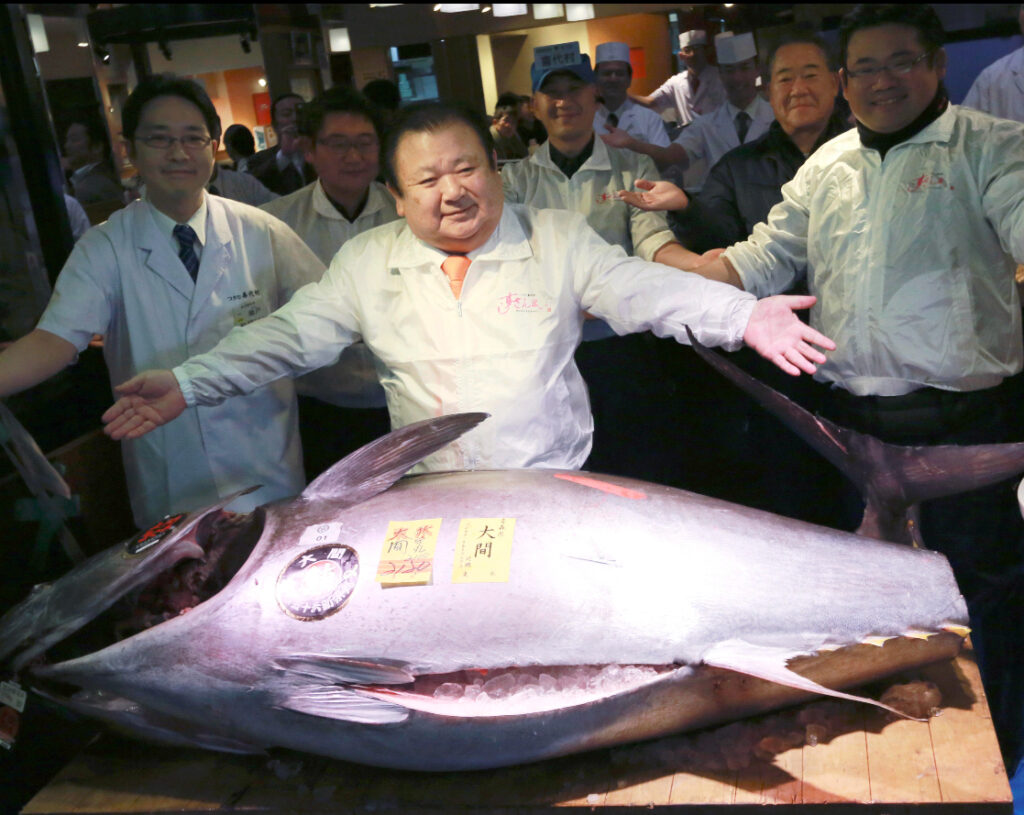On Sunday morning, the Tokyo fish market witnessed an extraordinary spectacle—a 608-pound bluefin tuna sold for a staggering $1.3 million at auction. The fish, often compared in size to a grizzly bear, a motorbike, or a cow, sparked awe not just for its size, but for the astounding price it fetched. The buyer? The Onodera Group, a Michelin-starred restaurant chain renowned for its high-quality sushi offerings and its dedication to securing the finest ingredients. This marks the fifth consecutive year that the Onodera Group has placed the highest bid, solidifying its dominance in Japan’s highly competitive seafood market.
Only one fish has ever sold for more at auction. In 2019, a slightly heavier 613-pound Oma bluefin tuna, likened to a mountain zebra or grand piano in size, made headlines with a record-breaking $3.1 million bid. These jaw-dropping figures raise important questions: What drives such astronomical prices? Why do bluefin tuna command such prestige? And what are the implications for conservation and sustainability?
The Bluefin Tuna: A Culinary Treasure
The bluefin tuna holds a place of reverence in Japanese cuisine, particularly in sushi and sashimi. Known as “maguro” or “honmaguro,” it is celebrated for its rich, buttery texture and umami-packed flavor. Among the various cuts of bluefin tuna, the prized otoro—the fatty belly meat—is considered a delicacy, sought after by sushi connoisseurs worldwide.
Japan, as the birthplace of sushi culture, is the world’s largest consumer of bluefin tuna. The fish’s role in traditional cuisine, coupled with the global popularity of sushi, has made bluefin a symbol of culinary luxury. Auctions like the one at Tokyo’s Toyosu Fish Market (formerly Tsukiji) showcase not only the premium quality of the fish but also the buyers’ commitment to offering the best to their customers.
For the Onodera Group, securing the highest bid is not just about obtaining the fish; it’s about reinforcing its brand as a purveyor of excellence. The group’s Michelin-starred status hinges on its ability to deliver unparalleled dining experiences, and sourcing the most exquisite ingredients is a crucial part of that equation.
The Prestige of the New Year Auction
The New Year auction at Tokyo’s fish market is more than a commercial transaction—it’s a cultural event. Taking place in early January, the auction symbolizes prosperity and good fortune for the year ahead. Winning the top bid is seen as a statement of success, ambition, and generosity.
For bidders like the Onodera Group, the auction serves as a platform to showcase their commitment to quality and their willingness to invest in the best. The publicity generated by winning the auction is invaluable, drawing attention not only from local customers but also from the global culinary community.
The event is steeped in tradition, with spirited bidding and a sense of camaraderie among participants. The atmosphere is electric, blending the excitement of competition with the reverence for the fish that lies at the heart of Japanese cuisine.
The Economics of Luxury Fish
The $1.3 million price tag on the 608-pound tuna translates to over $2,100 per pound. While this might seem exorbitant, it reflects the economics of scarcity and prestige. Bluefin tuna of this size and quality are rare, and their availability is diminishing due to overfishing and environmental challenges.
For high-end restaurants like those operated by the Onodera Group, investing in such a fish is a calculated decision. The purchase generates media attention, enhances the restaurant’s reputation, and justifies premium pricing for its dishes. Customers are often willing to pay a significant premium for the chance to taste such a rare and celebrated ingredient.
Conservation Concerns: The Other Side of the Story
While the auction highlights the cultural and economic significance of bluefin tuna, it also underscores the urgent need for conservation. Bluefin tuna populations have been declining for decades due to overfishing. The Atlantic bluefin tuna, in particular, has been classified as endangered, with the Pacific and Southern bluefin species also facing significant threats.
The global demand for bluefin tuna, fueled by sushi’s popularity, has placed immense pressure on wild populations. Although efforts have been made to regulate fishing and implement quotas, challenges persist. Illegal fishing, insufficient enforcement, and high market prices continue to incentivize unsustainable practices.
In recent years, there has been progress in sustainable aquaculture for bluefin tuna. Farms in Japan, Europe, and Australia are experimenting with breeding and raising bluefin in captivity, reducing reliance on wild stocks. However, these methods are still in their infancy and face obstacles such as high production costs and environmental impact.
The Role of Auctions in the Sustainability Debate
Critics argue that events like the New Year auction, with their sky-high bids, contribute to the overexploitation of bluefin tuna by glamorizing their consumption and driving up market demand. Others contend that such auctions spotlight the fish’s value, potentially encouraging conservation efforts.
In Japan, there is a growing awareness of the need to balance tradition with sustainability. The government has taken steps to regulate fishing and promote responsible consumption. At the same time, chefs and restaurateurs are beginning to explore alternative ingredients and sustainable practices, recognizing that the future of sushi depends on the health of the oceans.
A Symbol of Japanese Culture
Beyond its economic and environmental implications, the bluefin tuna is a symbol of Japanese culture. Its role in sushi, its presence in traditional celebrations, and its place in the global culinary landscape reflect the deep connection between Japan and the sea.
The auction at Toyosu Fish Market is not just about buying fish; it’s about honoring a tradition, celebrating craftsmanship, and showcasing the artistry of sushi. It is a reminder of the cultural significance of food and the importance of preserving the resources that make it possible.
Balancing Tradition and Sustainability
The sale of a 608-pound bluefin tuna for $1.3 million is a testament to the enduring appeal of this remarkable fish. For the Onodera Group, it represents an investment in quality, prestige, and tradition. For the broader culinary world, it highlights the bluefin’s status as a symbol of luxury and craftsmanship.
However, the auction also serves as a reminder of the challenges facing the oceans. As the demand for bluefin tuna continues to grow, the need for sustainable practices becomes increasingly urgent. Balancing tradition with conservation will be essential to ensuring that future generations can continue to enjoy the treasures of the sea.
The story of the million-dollar bluefin is one of contrasts—between luxury and scarcity, tradition and modernity, celebration and caution. It is a story that invites reflection on the values we place on food, culture, and the natural world.
No comments yet.







